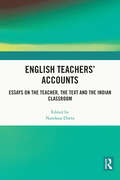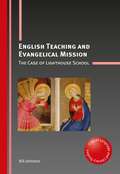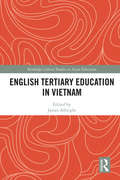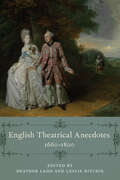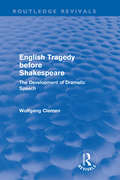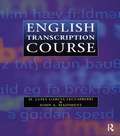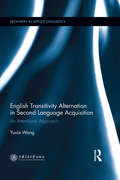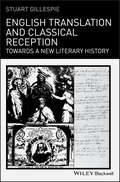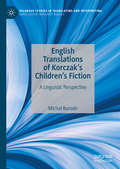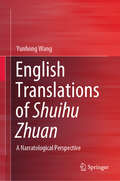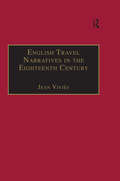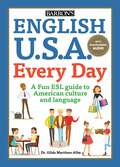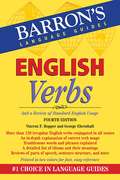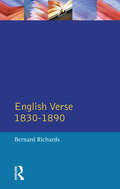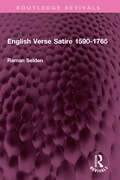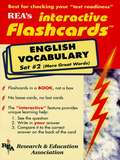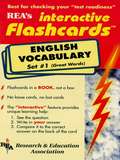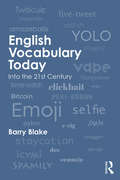- Table View
- List View
English Stylistics: A Cognitive Grammar Approach
by Zeki HamawandThis accessible textbook hinges on the central assumptions of Cognitive Linguistics and Cognitive Grammar, introducing students to the analytical tools they need to approach Stylistics, an essential area in language analysis. The author verifies the claim that alterations in style, triggered by different cognitive processes, reflect alterations in meaning, and shows how they are employed to achieve particular effects in context. The book links theory with practice, aiming both to acquaint students with the cognitive principles that account for stylistic expressions, and to provide them with the tools and techniques to conduct their own analyses. The textbook explores and explains how writers use the resources of language to create meaning, and how readers interpret texts. It will be of interest to advanced undergraduate and postgraduate students on courses in English Linguistics, as well as those working on other languages and in related areas such as Composition and Creative Writing.
English Teachers’ Accounts: Essays on the Teacher, the Text and the Indian Classroom
by Dutta NandanaThis book looks at the figure of the English teacher in Indian classrooms and examines the practice and relevance of English and India’s colonial legacy, many decades after independence. The book is an account of the varied experiences of teaching English in universities in different parts of the country. It highlights the changes in curriculum and teaching practices and how the discipline lent itself to a study of culture, historical contexts, the fashioning of identities or reform over the years. The volume presents the dramatic changes in the composition of the English classroom in terms of gender, class, caste and indigenous communities in recent decades, as well as the shifts in teaching strategies and curriculum which the new diversity necessitated. The essays in the collection also examine the distinctiveness of English practice in India through classroom accounts which explore themes like post-coloniality, feminism and human rights through the study of texts by Shakespeare, Beckett, Doris Lessing and poetry from the Northeast. This book will be of interest to academics, researchers, students and practitioners of English Studies, education, colonial studies, cultural studies and South Asian studies, as well as those concerned with the history of higher education and the establishment of disciplines and institutions.
English Teaching and Evangelical Mission: The Case of Lighthouse School
by Bill JohnstonDebates about the place of mission work in English Language Teaching continue to rage, and yet full-length studies of what really happens at the intersection of ELT and evangelical Christianity are rare. In this book, Johnston conducts a detailed ethnography of an evangelical language school in Poland, looking at its Bible-based curriculum, and analyzing interaction in classes for adults. He also explores the idea of ‘relationship’ in the context of the school and its mission activity, and more broadly the cultural encounter between North American evangelicalism and Polish Catholicism. The book comprises an in-depth examination of a key issue facing TEFL in the 21st century, and will be of interest to all practitioners and scholars in the field, whatever their position on this topic.
English Term-1 class 4 - Tamil Nadu Board
by State Council of Educational Research and Training Tamil NaduIn this book we will be knowing about the different kinds of works robots can be involved. Various hobbies and the time for a journey. Various new words and their meaning. Grammar portions such as Singular, Plural. Common and Proper Noun, Dialogue writings, Reading passages, Application form for annual day participation etc.
English Term-1 class 6 - Tamil Nadu Board
by State Council of Educational Research and TrainingThe Class 6 English Term 1 textbook, prepared by the Government of Tamil Nadu, is designed to make English learning engaging and effective for students. It follows the National Curriculum Framework, 2005, focusing on themes from the natural and social world to stimulate curiosity and imagination. The book comprises three units featuring prose, poetry, and supplementary stories like “Sea Turtles,” “When the Trees Walked,” and “A Visitor from Distant Lands.” Each unit introduces vocabulary, grammar, comprehension, and creative writing activities, with an emphasis on both individual and collaborative learning. Digital tools, such as ICT Corners and QR codes, promote digital literacy, while values-based learning is embedded through activities like “Connecting to Self” and “Steps to Success.” The content encourages higher-order thinking, promotes environmental and cultural awareness, and supports students in improving their language proficiency through active learning and storytelling.
English Term-2 class 4 - Tamil Nadu Board
by State Council of Educational Research and Training Tamil NaduThe textbook delves into the dual themes of affection and savings, encompassing essential grammar topics like Prefixes, Suffixes, Punctuation, Prepositions, and Tenses. It elucidates the concept of real wealth and what individuals typically save, advocating for wise financial decisions. Through dialogues between various characters such as a ticket collector and a passenger, and a banker and his customer, it explores practical scenarios related to saving and financial transactions. Additionally, the textbook includes guidance on effective communication through advertisement creation, paragraph and passage writing, as well as practical tools like a bank challan and withdrawal slip. Overall, it aims to equip readers with both linguistic proficiency and financial literacy, emphasizing the importance of prudent saving and meaningful relationships.
English Term-2 class 7 - Tamil Nadu Board
by Government of Tamil NaduThe seventh-grade English textbook for Term 2, published under the Free Textbook Programme of the Government of Tamil Nadu, is designed to make learning English both effective and enjoyable. Following the National Curriculum Framework 2005 guidelines, the book balances language structure and vocabulary with practical usage. It features graded activities to gradually build language proficiency, encourages individual and collaborative learning, and supports differentiation in multilevel classrooms. Each unit includes an ICT Corner to develop digital literacy. The textbook comprises two units and one play, with themes that engage students' curiosity and imagination. Activities range from creative writing and grammar games to projects that develop higher-order thinking skills. Learning outcomes emphasize reading, vocabulary, critical thinking, creative writing, and the practical application of grammar. The units cover prose, poetry, and supplementary readings, with each section designed to foster active learning and enjoyment of literature.
English Term-3 class 7 - Tamil Nadu Board
by Government of Tamil NaduThe Tamil Nadu State Board English textbook for 7th grade, Term 3, provides a rich blend of literature and interactive learning. It begins with a journey through Jules Verne’s "Around the World in Eighty Days," exploring early railway challenges, and includes John Masefield’s poem "Sea Fever," which expresses a longing for the sea. The supplementary story, "Sindbad the Sailor," recounts Sindbad’s first voyage. Unit 2 highlights the bravery of Neerja Bhanot, a flight attendant who sacrificed her life during a hijacking, paired with Edgar Albert Guest’s poem "Courage" and the rescue story "Man Overboard." The third unit features an excerpt from Charlotte Bronte’s "Jane Eyre," focusing on Jane's difficult childhood and experiences at Lowood School. The textbook integrates digital elements such as QR codes for interactive learning, grammar games, and includes sections on grammar, vocabulary, writing, and collaborative projects. It aims to make English learning engaging and effective by connecting students to self through values and encouraging curiosity and imagination.
English Tertiary Education in Vietnam (Routledge Critical Studies in Asian Education)
by James AlbrightAs part of a long series of Vietnam’s policy objectives, English education has been identified as key to improving the quality of its rapidly expanding tertiary institutions and is crucial to the larger aim of modernising and internationalising its economy. Bringing together a wide range of Vietnamese and foreign English education scholars, and tertiary educational practitioners, this book documents the significant progress and challenges in the realisation of Vietnam’s English language policies as they are enacted in the higher education sector. Changes to Vietnam’s higher education system remain unstable, unsystematic, and insubstantial. This book provides insights into how recent Vietnamese government policy is providing for a substantial and comprehensive renewal of Vietnam’s tertiary education as part of their 2020 plan. Academics and students of English education, language policy, and nation building within the context of increased globalisation and marketisation in developing nations and Vietnam, in particular, should find this book valuable.
English Theatrical Anecdotes, 1660-1800 (Performing Celebrity)
by Fiona Ritchie Leslie Ritchie Michael Burden Danielle Bobker Chelsea Phillips Máire MacNeill Heather Ladd Nevena Martinovic Seth Wilson Elaine McGirr Amanda Weldy BoydThe essays in English Theatrical Anecdotes, 1660-1800 explore the theatrical anecdote’s role in the construction of stage fame in England’s emergent celebrity culture during the long eighteenth century, as well as the challenges of employing such anecdotes in theatre scholarship today. This collection showcases scholarship that complicates the theatrical anecdote and shows its many sides and applications beyond the expected comic punch. Discussing anecdotal narratives about theatre people as producing, maintaining, and sometimes toppling individual fame, this book crucially investigates a key mechanism of celebrity in the long eighteenth century that reaches into the nineteenth century and beyond. The anecdote erases boundaries between public and private and fictionalizing the individual in ways deeply familiar to twenty-first century celebrity culture.
English Tragedy before Shakespeare: The Development of Dramatic Speech (Routledge Revivals)
by Wolfgang ClemenFirst published in English in 1961, this reissue relates the problems of form and style to the development of dramatic speech in pre-Shakespearean tragedy. The work offers positive standards by which to assess the development of pre-Shakespearean drama and, by tracing certain characteristics in Elizabethan tragedy which were to have a bearing on Shakespeare’s dramatic technique, helps to illuminate the foundations on which Shakespeare built his dramatic oeuvre.
English Transcription Course
by Maria Lecumberri J. A. MaidmentHave you ever been confused by the fact that the words 'though' and 'bough' are pronounced differently, or frustrated by the realisation that 'hint' and 'pint' don't rhyme? It is well known that the spelling system of English is notoriously unhelpful as an indicator of how to pronounce English words. Spoken and written representations of English are mutually inconsistent, making it difficult to interpret the 'logic' of the language. Learning to transcribe English phonetically, however, provides an accurate visual interpretation of pronunciation: it helps you to realise what you actually say, rather than what you think you say.English Transcription Course is the ideal workbook for anyone wishing to practice their transcription skills. It provides a series of eight lessons, each dealing with a particular aspect of pronunciation, and introduces and explains the most important features of connected speech in modern British English - such as assimilation, elision and weak forms, concentrating on achieving a relaxed, informal style of speech. Each lesson is followed by a set of exercises which allow for extensive practise of the skills learnt in both current and previous chapters. Students can check their progress with the 'model' answers provided in the appendix.
English Transitivity Alternation in Second Language Acquisition: an Attentional Approach (Frontiers in Applied Linguistics)
by Yuxia WangThe correct use of English verb argument structure is crucial for foreign learners of the English language. Based on an experimental study recruiting 162 Chinese English learners at different proficiency levels, this book suggests that the acquisition of English transitivity alternation follows as a consequence of the cognitive processing of language input, which is induced by the nature of task requirements in different learning conditions and influenced by individual differences in language learning aptitude and proficiency level. Readers of this book will have a deeper understanding of all these variables involved and will learn that pedagogical issues should be considered in a more thorough, comprehensive manner to explore better solutions for English learning and teaching.
English Translation and Classical Reception: Towards a New Literary History (Classical Receptions)
by Stuart GillespieEnglish Translation and Classical Reception is the first genuine cross-disciplinary study bringing English literary history to bear on questions about the reception of classical literary texts, and vice versa. The text draws on the author’s exhaustive knowledge of the subject from the early Renaissance to the present. The first book-length study of English translation as a topic in classical reception Draws on the author’s exhaustive knowledge of English literary translation from the early Renaissance to the present Argues for a remapping of English literary history which would take proper account of the currently neglected history of classical translation, from Chaucer to the present Offers a widely ranging chronological analysis of English translation from ancient literatures Previously little-known, unknown, and sometimes suppressed translated texts are recovered from manuscripts and explored in terms of their implications for English literary history and for the interpretation of classical literature
English Translations of Korczak’s Children’s Fiction: A Linguistic Perspective (Palgrave Studies in Translating and Interpreting)
by Michał BorodoThis book investigates major linguistic transformations in the translation of children’s literature, focusing on the English-language translations of Janusz Korczak, a Polish-Jewish children’s writer known for his innovative pedagogical methods as the head of a Warsaw orphanage for Jewish children in pre-war Poland. The author outlines fourteen tendencies in translated children’s literature, including mitigation, simplification, stylization, hyperbolization, cultural assimilation and fairytalization, in order to analyse various translations of King Matt the First, Big Business Billy and Kaytek the Wizard. The author then addresses the translators’ treatment of racial issues based on the socio-cultural context. The book will be of use to students and researchers in the field of translation studies, and researchers interested in children’s literature or Janusz Korczak.
English Translations of Shuihu Zhuan: A Narratological Perspective
by Yunhong WangThis book offers a novel perspective on the intersection of translation and narration in literary translation by investigating how three translations of Shuihu Zhuan present the original narrative mode to the target readership in terms of four narrative elements—voice, commentary, point of view and motif—in different periods of history. It not only validates but also quantifies the differences in strategy-making patterns between translators, as well as between different narratological categories. The established theoretical frameworks (including a narrative-descriptive model and a sociological explanatory framework) and the data collected may provide methodological and empirical support for further studies on shifts of narrative features in translation. The tendencies manifested by different translators and identified by the study may also shed new light on the teaching and learning of translation skills.The book offers a valuable reference guide for scholars, practitioners, translators and graduate students in the fields of e.g. language, translation, literature and cultural studies, and for anyone with an interest in Chinese classical literature, Chinese-English translation, narrative studies or cross-cultural studies.
English Travel Narratives in the Eighteenth Century: Exploring Genres (Studies in Early Modern English Literature)
by Jean VivièsThe eighteenth century, commonly described as the age of the novel, is also the golden age of travel narratives. In this English edition of Le Récit de voyage en Angleterre au XVIIIe siècle, the genre of the travel narrative receives a treatment based on its development in close relationship with fiction. The book provides a survey of famous travel narratives: James Boswell's journal of a tour to Corsica and account of his trip to Scotland with Samuel Johnson, Laurence Sterne's enigmatic Sentimental Journey, Tobias Smollett's Travels through France and Italy. Negotiating between inventory and invention, these texts invite a reconsideration of conventional generic distinctions. They open up a literary space in which the full significance of the real and fictional journey motif can be explored.
English U.S.A. Every Day With Audio (Barron's Foreign Language Guides)
by Gilda Martinez-AlbaA fun ESL guide to American culture and language. English USA Every Day helps familiarize immigrants and ESL learners with American culture and language in a fun, lighthearted way. Readers will learn about everything from finding a job and locating an organic grocery store to facts about American culture and enjoying the night life. Each chapter includes new vocabulary and idioms that are common in the U.S.A., as well as fun activities such as true or false questions, crosswords, matching games, "Write It Down," "Stop and Think," "Story Time," and more that help reinforce the lessons. There are also 2—4 dialogues in each chapter that show how people speak conversationally, with new vocabulary and idioms to learn and practice. Click on the dialogue box (i.e. Dialogue 2) to hear the audio. You can then minimize the audio progression screen and go back to reading the dialogue while you listen to it. An answer key is included at the back of the eBook.
English Verbs (Barron's Verb Series)
by F. Vincent HopperThe new edition of this quick-reference book makes a handy classroom supplement for high school and college students, and serves as a valuable language aid for ESL students. Helpful features include: 120 irregular verbs conjugated in all tenses A special section on phrasal verbs A review of standard English usage Troublesome words and phrases Rules of punctuation Small in format but packed with information, this book fits easily in backpacks or attaché cases for taking to class or carrying along to study sessions.
English Verse 1830 - 1890 (Longman Annotated Anthologies of English Verse)
by Alastair Fowler Bernard Richards Brian RichardsThis popular anthology provides a collection of the most significant Victoran verse xxx; including some minor figures notably John Clare, Emily Bronte and James Thomson. Fully annotated, this collection contains introductions to individual poets, headnotes to the poems and full and informative footnotes. It represents Victorian poetic taste at its best and is the ideal companion for everyone interested in poetry of the period.
English Verse Satire 1590-1765 (Routledge Revivals)
by Raman SeldenFirst published in 1978 English Verse Satire aims to provide a critical study of the major English verse satirists as well as an account of the historical development of verse satire. Critical accounts are offered of important writers including Donne, Vaughan, Butler, Rochester, Dryden, Oldham, Swift, Pope, Young, Dr. Johnson and Churchill. An account of verse satire commences historically with the Roman satirists and Dr Selden has provided a substantial treatment of Horace and Juvenal as the basis for a study of the evolution of verse satire from the Elizabethan period to the end of the Augustan period. A special feature of the book is the emphasis on tradition, continuity, and innovation. This book is an interesting read for scholars of English literature.
English Vocabulary - Set #2 Interactive Flashcards Book
by The Editors of REAREA’s Interactive Flashcard books represent a novel approach which combines the merits of flash cards with the ease of using a book. One side of each page includes questions to be answered, with space for writing in one’s answers — a feature not usually found on flash cards. The flip side of the same page contains the correct answers, much as flash cards do. English Vocabulary (Set #2) is fully indexed making it easy to locate topics for study. Thanks to the book form, there is no need to look for and fish out appropriate questions from a box and put them back in the proper order, and there is no need to carry around a box of 1,000 flash cards. The book is easier to take along and carry.
English Vocabulary - Set #2 Interactive Flashcards Book
by The Editors of REAREA's Interactive Flashcard books represent a novel approach which combines the merits of flash cards with the ease of using a book. One side of each page includes questions to be answered, with space for writing in one's answers -- a feature not usually found on flash cards. The flip side of the same page contains the correct answers, much as flash cards do. English Vocabulary (Set #2) is fully indexed making it easy to locate topics for study. Thanks to the book form, there is no need to look for and fish out appropriate questions from a box and put them back in the proper order, and there is no need to carry around a box of 1,000 flash cards. The book is easier to take along and carry.
English Vocabulary Today: Into the 21st Century
by Barry J. BlakeEnglish Vocabulary Today: Into the 21st Century offers an innovative perspective on the ways in which contemporary English language vocabulary continues to adapt and grow in light of emerging technologies and ideas. The book begins with a concise history of the English language, followed by chapters covering key topics including lexical change, semantic change and word-formation. Additional chapters highlight unique topics not often covered in English language studies, including the mental lexicon, inclusive language and the importing and exporting of words between English and other languages. Chapter discussions are enhanced by dynamic examples from a wide range of varieties of English, including American, British, Australian, New Zealand, Canadian, South African and South Asian. Taken together, English Vocabulary Today: Into the 21st Century offers students a clear and comprehensive understanding of the multi-faceted nature of English vocabulary today as well as new insights into its continued development.

